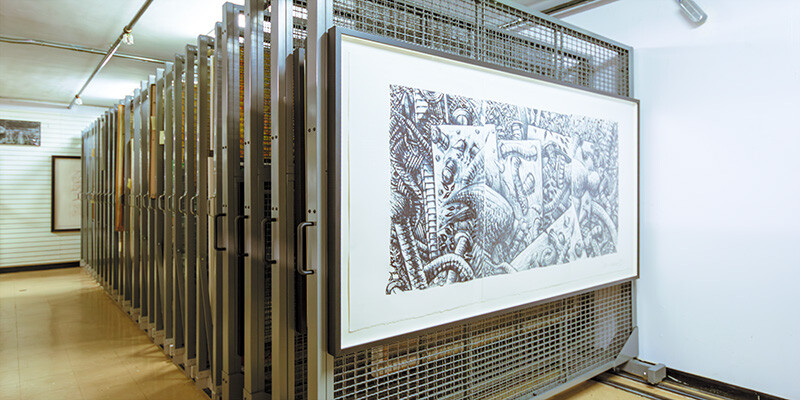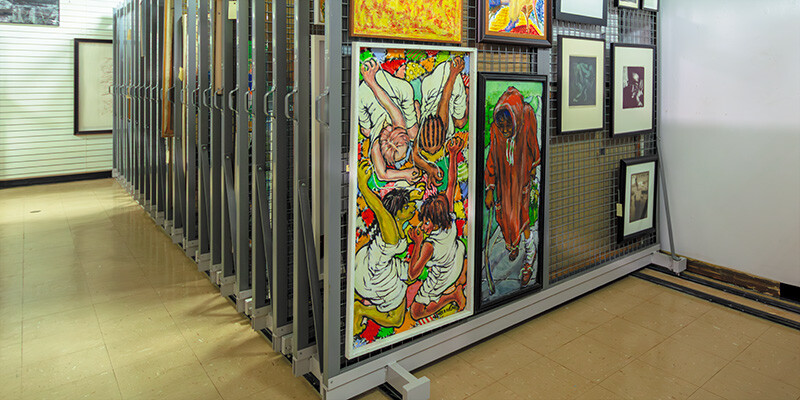For art to be fully appreciated, it needs to be experienced up close, in context, and with care. At the Clark Atlanta University (CAU) Art Museum, more than 1,200 works spanning African American modern art and traditional African art make up a collection that's as culturally rich as it is visually powerful.
But like many institutions, the museum faced a familiar challenge: how to store and access a growing number of important works that couldn't all be on display at once. That need sparked a creative rethink — not just of art gallery storage, but of how space itself could better support education, preservation, and engagement.
What followed was a renovation that added new storage capacity and transformed an underused room into a flexible object study classroom. The result? A more efficient, accessible space where students, faculty, and visitors can interact with the collection in meaningful new ways.
Building on a Strong Foundation
When Maurita Poole Ph.D., became director of the Clark Atlanta University Art Museum, she inherited more than an impressive collection. She also inherited the challenge of storing it. Back in the mid-1990s, her predecessor had worked with Spacesaver to install a series of art racks and flat files in the museum's basement. It was a big step forward at the time.

"In 1996, the institution had never had anything like it," Dr. Poole recalled. "We initially had 44 racks installed. We added another eight and that's going to be joined by another eight very soon, giving us 60 in total."
As the museum's collection grew, so did the need for better art gallery storage. Works on paper, unframed paintings, and large-scale contemporary pieces were stored out of sight, limiting how they could be accessed, studied, or displayed.
"I wanted to get more of the works framed and added to the racks," said Dr. Poole. "Many contemporary artists are creating large lithographs and oversized pieces, and I want to be able to show those. And when people offer to gift works to the museum, we need to have the space to accommodate them."
The addition of new art racks didn't just expand the museum's storage capacity. It made the collection more accessible. Students, scholars, and visitors can now view pieces that aren't currently on display, helping to deepen their understanding of artistic styles, eras, and individual artists.
Changing Perspectives
Dr. Poole had a vision: a space where faculty, students, and researchers could go beyond simply viewing art — a place where they could get up close, interact with it, and spark new ideas.
"Our museum has about 2,500 square feet for exhibitions," she said. "But I wanted somewhere we could bring out additional works for people to study and really engage with. That's how the idea of the 'object study classroom' was born."

She'd seen similar spaces at institutions like Princeton, Yale, and Cornell. And for CAU, a teaching museum with a deep commitment to community, the idea made perfect sense.
The only problem? The room she had in mind wasn't exactly gallery-ready. It was a bit of a storage graveyard, filled with casework, unused equipment, and leftovers from past renovations. But she knew it could be something more.
"I wanted a room where we could bring up works for folks to look at and interact with," Dr. Poole said. "People would come in and ask, 'Don't you have a Charles White piece?' I needed a space where I could show those works — even if they weren't in the main exhibit."
A Space for Curiosity, Connection, and Creative Study
Once the clutter was cleared and the space opened up, the vision really started to come together. Along one wall, Patterson Pope installed a 960-square-foot slat wall, perfect for hanging framed paintings during study sessions. Nearby, 16 tables and 32 chairs in CAU's signature colors (thanks to KI) gave the room a flexible layout that could shift to meet different class and collection needs.
It didn't take long for students to bring that space to life.
"Sometimes we'll have a group of students come in from Spelman College," Dr. Poole said. "They'll be doing a curatorial study. I'll put a set of ten items on the tables and the slat wall and ask them, 'If you were the curator, how would you organize these? What themes would you explore?' It's almost like a design thinking course."

In other words, this isn't just storage — it's inspiration in motion. It's a living classroom that bridges preservation and participation, all made possible by intentional design and thoughtful art gallery storage solutions.
A Foundation for the Future
The new object study classroom and expanded basement storage area aren't just functional wins. They've become key stops on campus tours and donor visits, tangible proof of the museum's momentum. And Dr. Poole is already looking ahead. Plans are in motion to add more flat files (including some with glass tops) and increase seating capacity to 30, making the space even more engaging and accessible.

Clark Atlanta University has long been a center for art education, and that commitment is only growing stronger. With smart planning, creative thinking, and the right partners, the CAU Art Museum is showing what's possible when art gallery storage does more than just store. It supports, inspires, and elevates the entire experience.
To learn more about this transformation, check out our case study. Or, if you're looking to create or upgrade your own art gallery storage space, reach out to a Patterson Pope representative today and start the conversation.

















